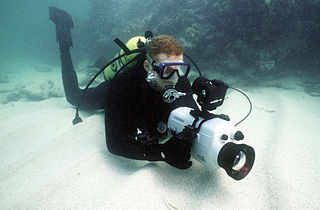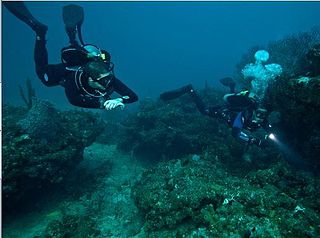
The Segway is a two-wheeled, self-balancing personal transporter invented by Dean Kamen and brought to market in 2001 as the Segway HT, subsequently as the Segway PT, and manufactured by Segway Inc. HT is an initialism for "human transporter" and PT for "personal transporter."

Underwater videography is the branch of electronic underwater photography concerned with capturing underwater moving images as a recreational diving, scientific, commercial, documentary, or filmmaking activity.

A dive computer, personal decompression computer or decompression meter is a device used by an underwater diver to measure the elapsed time and depth during a dive and use this data to calculate and display an ascent profile which, according to the programmed decompression algorithm, will give a low risk of decompression sickness.

Diving activities are the things people do while diving underwater. People may dive for various reasons, both personal and professional. While a newly qualified recreational diver may dive purely for the experience of diving, most divers have some additional reason for being underwater. Recreational diving is purely for enjoyment and has several specialisations and technical disciplines to provide more scope for varied activities for which specialist training can be offered, such as cave diving, wreck diving, ice diving and deep diving. Several underwater sports are available for exercise and competition.

A diver propulsion vehicle (DPV), also known as an underwater propulsion vehicle, sea scooter, underwater scooter, or swimmer delivery vehicle (SDV) by armed forces, is an item of diving equipment used by scuba divers to increase range underwater. Range is restricted by the amount of breathing gas that can be carried, the rate at which that breathing gas is consumed, and the battery power of the DPV. Time limits imposed on the diver by decompression requirements may also limit safe range in practice. DPVs have recreational, scientific and military applications.

The Ford Ranger EV is a battery powered compact pickup truck that was produced by the Ford motor company and was Ford's first all-electric production vehicle. It was produced starting in the 1998 model year through 2002 and is no longer in production. It is built upon a light truck chassis used in the Ford Explorer. A few vehicles with lead-acid batteries were sold, but most units were leased for fleet use. A few persistent and interested private parties were able to obtain leases over a period of three to five years. All leases were terminated in 2003–04, and the vehicles were recalled.

Sidemount is a scuba diving equipment configuration which has scuba sets mounted alongside the diver, below the shoulders and along the hips, instead of on the back of the diver. It originated as a configuration for advanced cave diving, as it facilitates penetration of tight sections of cave, allows easy access to cylinder valves, provides easy and reliable gas redundancy, and tanks can be easily removed when necessary. These benefits for operating in confined spaces were also recognized by divers who conducted technical wreck diving penetrations.

Diver navigation, termed "underwater navigation" by scuba divers, is a set of techniques—including observing natural features, the use of a compass, and surface observations—that divers use to navigate underwater. Free-divers do not spend enough time underwater for navigation to be important, and surface supplied divers are limited in the distance they can travel by the length of their umbilicals and are usually directed from the surface control point. On those occasions when they need to navigate they can use the same methods used by scuba divers.

Technical Diving International (TDI) claims to be the largest technical diving certification agency in the world, and one of the first agencies to offer mixed gas and rebreather training. TDI specializes in more advanced Scuba diving techniques, particularly diving with rebreathers and use of breathing gases such as trimix and heliox.

Flyscooters, formerly known under the name Znen, was an American company that marketed gas-powered motor scooters manufactured in China and Taiwan. The company was founded in 2006 in Florida by scooter enthusiasts Leon Li and Daniel Pak, and ceased operations in 2010. During the operating life of the company, Flyscooters' basic business model was to import low-cost scooters from abroad and distribute them under the Fly brand name to a network of retail scooter dealerships across the United States, providing dealers with warranty and spare parts support.

Ralph Osterhout is an American inventor, designer, entrepreneur, and CEO of Osterhout Design Group (ODG). During his career he has developed a range of products spanning toys, consumer electronics, dive equipment, furniture to devices for the Department of Defense. Osterhout is named as inventor on 260 patents and patent applications. Over the course of his career, Osterhout has developed over 2,000 different products and hundreds of separate product lines for companies ranging from start-ups to Fortune 500s, as well as the government.
The National Association for Cave Diving (NACD) was founded in 1968 with the goal of improving the safety of scuba diving in caves through training and education. A non-profit corporation, the NACD has its headquarters in Gainesville, Florida but is conducting its administration and operations from High Springs, Florida.

The Seaview SVII is an underwater camera designed by the Catlin Seaview Survey team, intended to photograph coral reefs to provide visual documentation of a reef's health. The camera is designed to be controlled by a diver in shallow waters, and is propelled at a constant slow speed by a propeller mounted near the rear of the camera. Only two SVIIs are currently in existence. The cameras were used by the Catlin Seaview Survey and Google to create Google Ocean, a means of displaying underwater images using Google's existing Street View platform.
Shearwater Research is a Canadian manufacturer of dive computers and rebreather electronics for technical diving.

A dive light is a light source carried by an underwater diver to illuminate the underwater environment. Scuba divers generally carry self-contained lights, but surface supplied divers may carry lights powered by cable supply.

Doing It Right (DIR) is a holistic approach to scuba diving that encompasses several essential elements, including fundamental diving skills, teamwork, physical fitness, and streamlined and minimalistic equipment configurations. DIR proponents maintain that through these elements, safety is improved by standardizing equipment configuration and dive-team procedures for preventing and dealing with emergencies.

The history of scuba diving is closely linked with the history of the equipment. By the turn of the twentieth century, two basic architectures for underwater breathing apparatus had been pioneered; open-circuit surface supplied equipment where the diver's exhaled gas is vented directly into the water, and closed-circuit breathing apparatus where the diver's carbon dioxide is filtered from the exhaled breathing gas, which is then recirculated, and more gas added to replenish the oxygen content. Closed circuit equipment was more easily adapted to scuba in the absence of reliable, portable, and economical high pressure gas storage vessels. By the mid-twentieth century, high pressure cylinders were available and two systems for scuba had emerged: open-circuit scuba where the diver's exhaled breath is vented directly into the water, and closed-circuit scuba where the carbon dioxide is removed from the diver's exhaled breath which has oxygen added and is recirculated. Oxygen rebreathers are severely depth limited due to oxygen toxicity risk, which increases with depth, and the available systems for mixed gas rebreathers were fairly bulky and designed for use with diving helmets. The first commercially practical scuba rebreather was designed and built by the diving engineer Henry Fleuss in 1878, while working for Siebe Gorman in London. His self contained breathing apparatus consisted of a rubber mask connected to a breathing bag, with an estimated 50–60% oxygen supplied from a copper tank and carbon dioxide scrubbed by passing it through a bundle of rope yarn soaked in a solution of caustic potash. During the 1930s and all through World War II, the British, Italians and Germans developed and extensively used oxygen rebreathers to equip the first frogmen. In the U.S. Major Christian J. Lambertsen invented a free-swimming oxygen rebreather. In 1952 he patented a modification of his apparatus, this time named SCUBA, an acronym for "self-contained underwater breathing apparatus," which became the generic English word for autonomous breathing equipment for diving, and later for the activity using the equipment. After World War II, military frogmen continued to use rebreathers since they do not make bubbles which would give away the presence of the divers. The high percentage of oxygen used by these early rebreather systems limited the depth at which they could be used due to the risk of convulsions caused by acute oxygen toxicity.

The following index is provided as an overview of and topical guide to underwater diving:
Diving support equipment is the equipment used to facilitate a diving operation. It is either not taken into the water during the dive, such as the gas panel and compressor, or is not integral to the actual diving, being there to make the dive easier or safer, such as a surface decompression chamber. Some equipment, like a diving stage, is not easily categorised as diving or support equipment, and may be considered as either.

Human factors in diving equipment design are the influence of the interaction between the diver and the equipment on the design of the equipment. The underwater diver relies on various items of diving and support equipment to stay alive, in reasonable comfort and to perform the planned tasks during a dive. The design of the equipment can strongly influence its effectiveness in performing the desired functions.

















